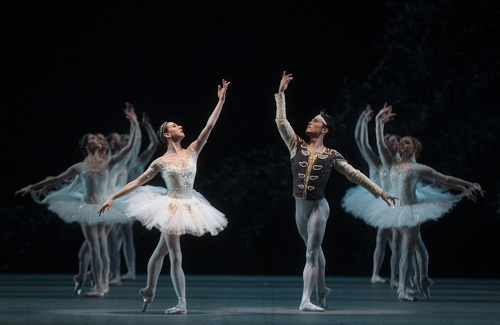 United States Minkus, La Bayadère: Dancers of American Ballet Theatre / Ormsby Wilkins (conductor), Dorothy Chandler Pavilion, Los Angeles, 14.7.2018. (JRo)
United States Minkus, La Bayadère: Dancers of American Ballet Theatre / Ormsby Wilkins (conductor), Dorothy Chandler Pavilion, Los Angeles, 14.7.2018. (JRo)

Cast:
Nikiya – Isabella Boylston
Solor – Jeffrey Cirio
The Radjah Dugumanta – Alexei Agoudine
Gamzatti – Misty Copeland
High Brahmin – Roman Zhurbin
Aya – Isadora Loyola
Head Fakir – Arron Scott
Principal Shades – Sarah Lane, Cassandra Trenary, Breanne Granlund
Bronze Idol – Joseph Gorak
Production:
Choreography – Natalia Makarova after Marius Petipa
Musical Arrangement – John Lanchbery
Director – Natalia Makarova
Sets – Pierluigi Samaritani
Costumes – Theoni V. Aldredge
Lighting – Toshiro Ogawa
With a convincing ballerina in the role of Nikiya, the temple dancer, the problematic ballet La Bayadère can be elevated from tepid to engaging. Isabella Boylston offered a poignant portrayal of the jilted dancer, raising the level of Marius Petipa’s creation as re-choreographed by legendary ballerina Natalia Makarova.
Boylston, with her superb musicality, exquisite feet and committed performance, put me in mind of Makarova in her many singular roles danced with ABT in the 1970s. It was Makarova who, in 1974, introduced New York to Bayadère’s Act II, ‘Kingdom of the Shades’, with the luminous Cynthia Gregory dancing the role of Nikiya. It was a much belated addition to the repertory in the U.S. and enthusiastically embraced by audiences and critics alike.
In a haunting cascade of white tutus, dancers descend a ramp and move slowly forward, alternating arabesques with arched backs and uplifted rounded arms until they form a zigzagging line of 24 maidenly shades – producing an effect similar to the ghostly Willis of Giselle. Unleashed from the full-length work, this act stands alone beautifully, a masterpiece of classical ballet, and it was superbly danced here by the ABT corps along with the three soloists, Sarah Lane, Cassandra Trenary and Breanne Granlund.
It is the surrounding narrative and musical creation that produced a questionable effect. The Khudekov libretto is as clichéd as any forgettable romantic potboiler. After pledging his undying love to Nikiya, Solor, a young warrior of ancient India, agrees to marry Gamzatti, the Rajah’s daughter, and abandons the temple dancer. It is a cowardly act, and the guilt-ridden Solor suffers for it. The High Brahmin, in love with Nikiya and jealous of her steadfast affection for Solor, tells the Rajah and Gamzatti of Nikiya’s attachment to the warrior. Rajah and his daughter murder her with a poisonous snake. Solor, driven to despair and finding solace in opium, hallucinates the ‘Kingdom of the Shades’ Act and is momentarily reunited with Nikiya in his dreams. The marriage to Gamzatti proceeds, but Nikiya is able to inflict retribution: the temple where the ceremony takes place collapses in an earthquake and everyone perishes. In an apotheosis, Nikiya and Solor are reunited.
In 1980, Makarova, who had danced the ballet during her career with the Kirov, choreographed the work in its entirety. Though the full work offers us a window through which to view the ‘Kingdom of the Shades’, it is ultimately an unsatisfying and stilted ballet. Not only does it engage in stereotypes of the exotic ‘other’, but the music by Minkus is at odds with the setting.
Examples of evocative music by composers celebrating other cultures abound: Rimsky-Korsakov’s Scheherazade, Verdi’s Aida or Bizet’s Carmen to name a few. Unfortunately, today Ludwig Minkus’s 1877 score feels predictable and trite with its regular harmonic patterns and flourishes, creating a disconnect between the subject matter and the music. We are adrift in a European sound world and asked to believe in tales of Brahmins and bayadères.
Jeffrey Cirio partnered Boylston in the role of Solor; virtuosic dancing and elegance marked his performance. Misty Copeland made a strong impression as the imperious Gamzatti, though I puzzled over her hand movements. With fingers flared like an open fan, they proved a distraction. As the kitschy Bronze Idol of Act III, Joseph Gorak, painted head to toe in golden hues, was a showstopper.
The beautiful sets by Pierluigi Samaritani had a nineteenth-century flavor but, unfortunately, they reinforced the dated feel of the ballet. Theoni V. Aldredge’s costumes were ravishing with their palette of soft gold, white and salmon. Together the sets and costumes provided spectacular underpinnings for this traditional story ballet. Ormsby Wilkins lovingly conducted Minkus’s score with an orchestra made up of local musicians, principally of the LA Opera Orchestra.
Jane Rosenberg